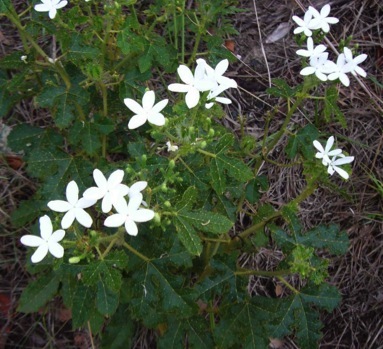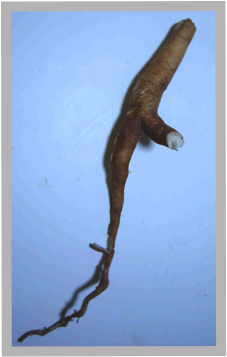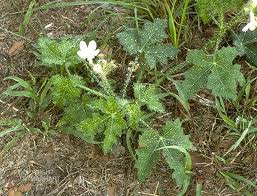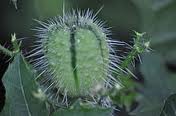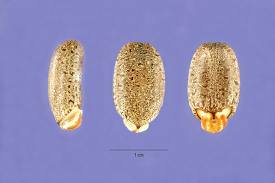Cnidolscolus Stimulosus: It’s The Real Sting
This is how to not dig up a spurge nettle root: Take a shovel, find a plant, and start digging.
When I first started digging for spurge nettle roots (Cnidoscolus stimulosus) I couldn’t find any. I could locate and identify the plant with no problem. And, like many reports, I would dig and dig and dig and not find the root. In one account someone dug down six feet in a dune and still didn’t find the root. I spent more energy digging a hole than any root was ever going to give back in calories. I nearly gave up on ever actually finding a spurge nettle root. Then one day I was filling in yet another deep hole when I happened to notice a small piece of root was on the bottom of the huge heap of sand I had piled up…. and as they say, suddenly it all clicked and I have never failed to find a root since, and always within a foot of the soil’s surface.
What’s the secret? Well, the first thing is the spurge nettle root is, literally, fragile. It breaks very easily. Next, it tends to be, on the outside, the same color of the soil it’s in. When most people dig for the root they dig the wrong way and actually throw the root away with the dirt, never seeing the broken pieces. Here’s the right way:
Find the plant. Using your shovel, measure out a shovel blade’s width away from the plant. Now start digging. You are digging a hole that is at least a half a foot or more to one side of the plant’s main stem. Dig down a foot. By now you should have also gotten rid of all of the plant above ground (not with your hands!) Using the side of the shovel at the bottom of your hole, start shaving the dirt away, horizontally towards the vertical root where the plant was. Take your time. By the the time you find the root, you will have a hole that is roughly shaped like a lop-sided triangle.
Reach in the hole now and then find the root. Don’t worry. The nettle stings only from just below the ground up. Once you find the root, finish digging by hand, or with a trowel. Remove all the dirt away from the root. If you pull on it in any way it will snap. Of course, you can cook it whole or in parts. It’s kind of shaped like a cross between a carrot and large sausage with a potato- or earth-colored skin. The bottom end does get skinnier so you will have to break it at some point and trim off the stem top.
I boil the spurge nettle root then peel it, like a potato. Some times the outer cover come off more like bark, depending on the age of the root. It has a non-edible cord — read too tough to eat — up the middle that pulls out like a string. Once cooked, some folks put the root through a ricer to make it softer, I just chop it up. With butter, and a little salt and pepper, spurge nettle root tastes like pasta to me. Oh, and it is always al dente. It becomes edible but is never “soft” but rather like an old potato in texture. I recently read one reference that said don’t eat the upper portion of the roots. Never knew that, haven’t been bothered by said. I don’t eat the stem but the upper part of the root is the main part. I shall continue to eat the entire root. Beside, if there are cyanonic glycocides present they will be driven off by the boiling. Don’t cook in aluminum.
If you didn’t get rid up the above-ground part of the plant, you will probably converge with the spurge and have the urge to submerge the spot stung in cool water. The spines are like little glass spikes full of acid. Is the sting agony? No. Is it God awful? No. Does it burn? Oh, yes. Will it irritate you for an hour? Most certainly. Will you wish you hadn’t brushed up against it? Absolutely, but it is not horrible and it will be gone soon. (Our local “stinging nettle” in the Urtica genus is far, far worse.) Fire ants are far worse as well and they can make you itch for weeks. Be a man, even if you aren’t, and get on with digging up the root. The pain will pass in an hour or so. Eating the root will be just revenge for the sting.
That the root of the C. stimulosus is edible is not in question, but what about the seeds? In the book “Edible and Useful Plants of Texas and the Southwest: A Practical Guide” by Delena Tull, 1999, the author tells how to harvest the seeds of the Cnidoscolus texanus, a close cousin of the C. stimulosus. No mention is made about eating the root of the C. Texanus. That’s a tad odd. So, what about the seeds of the C. stimulosus since we know the root is edible? There are some unattributed comments on websites that say they are edible but no authorities quoted and no one saying they in fact ate some of the C. stimulosus seeds themselves.
In Florida Ethnobotany by Dr. Daniel F. Austin, 2004, he quotes Professor Julia Morton — the grand dame of botany in Florida — as saying the roots and the seeds of the C. stimulosus are edible, referencing her 1968 edition of “Wild Plants for Survival In South Florida.” That would seem to settle it since Morton was and still is the authority. However….
My concern is I own the fifth edition of that very same book printed in 1982, and referenced by Austin and the Orlando Public Library also has the 1962 edition. Despite Austin’s reference to it there is no reference to edible seeds of the Cnidoscolus stimulosus in either edition. Perhaps it was included in the 1968 edition but not the ’62 or the ’82, which are identical. It could also be a mis-reference and she wrote about it in some other book, or Austin just got it wrong. Morton was very careful and her word on poisonous plants is still law more than 20 years after her accidental death… no, it was a car accident not a plant accident. I have seen one reference to C. stimulosus saying the seeds were edible but no mention of the root, which is odd. I have yet to find in the same reference say the root AND the seeds are both edible, which makes me think folks are copying information and don’t really know. Incidentally, C. stimulosus is one of the few plants with milky sap that produces an edible root (cooked.)
There is a hint that the C. texanus root might be edible. A 1954 study said: “The root of C. texanus, heretofore not examined chemically, has been found to be high in carbohydrate content with alkaloids and glycosides absent, or present only in negligible quantities. Other interesting facts observed in this investigation indicate that the root system as well as other parts of the plant might be worthy of further investigation.”
Lack of alkaloids and glycosides is good news. I suspect the roots and seeds of each are edible but that is yet to be demonstrated. A 2007 study of the C. texanus root found 26 known compounds which included 15 flavonoids, three coumarins, three coumaric acid derivatives, four triterpenoids, one phytosterol and three new compounds… All flavonoids were found to be inactive against DNA topoisomerase. A 1957 study showed the seed oil of the C. texanus to be 28% protein, nearly 28% oil and 29% crude fiber. Ash 4%. The acids were oleic 24%, linoleic 59%, saturated 12%.
As for the scientific names, again opinions differ. Since the name is from Greek first a little lesson in Greek. Greek verbs have a main part, the stem, and an ending. The verb stem “to sting” is “tsou.” To that is added endings telling you who or what is stinging. Tsouzo (TSOU-zo) means I sting, tsouzee, means he, she, it stings. The word for nettles is tsouknitha (tsouk-NEE-tha) combining tsou with knitha, which might mean “it stings a little.”
So the genus name Cnidoscolus is from two Greek sources pulverized through Latin. Cnido is cleaved from tsouknitha (k-NEE-tha) The Romans had no “K” sound so they got rid of it and used C in front of the N to indicate it was from Greek and the C silent. Scolus is from the Greek word “skolop” meaning “a thorn” but with a Latin ending.
How that all is pronounced is a bit of preferences. kah-knee-doe-SKOHL-us is close to the original Greek, if you don’t mind cutting a word in half and adding a Latin ending. Anglicized Latin truly bastardizes the Greek, drops a syllable, changes the accent and pronunciation getting: nye-DOSE-ko-lus. I have also heard sss-need-doe-SKOHL-us which offends both languages. There is no beginning SN sound in native Greek or Latin.
The species name Stimulosus is from Latin stimul(us), meaning to “goad”, “prod” or “urge”. Its nickname in Spanish is Mala Mujer, “bad woman” but several plants carry that nickname. There are about 75 different spurge nettles worldwide.
Part of the common name, spurge nettle, reaches way back, about as far as records go. Spurge and purgatory come from the same Latin word, pugare, to purge. Nettle comes from Sanskrit which was nahyati. That passed into Latin as nassa, became nezzi in Old German and nettle in English. Nettle was a fiber plant and in Latin it meant fish net. So the spurge nettle captures you for pain…. sounds accurate to me.
Green Deane’s “Itemized” Plant Profile
IDENTIFICATION: Perennial plant to a foot high covered with stinging hairs; leaves alternate, simple, palmately 3-5 lobed; flowers white, tubular, appear to be five petals, fruit three-seeded capsule. It is reported to bloom all year here in Florida but it is most showy in the spring and early summer. (The C. texanus leaves are more crinkly than the leaves of the C. stimulosus.)
TIME OF YEAR: Gather any time, best in fall, the larger the plant the larger the tuber
ENVIRONMENT: Forest or other natural areas in sandy woods; old fields, roadsides, dry pastures, dunes. Its range is basically the antebellum South east of the Mississippi. C. Texanus is found west of the Mississippi. Louisiana has both.
METHOD OF PREPARATION: C. stimulosus: Boil whole like a potato, 20 minutes, does not get soft like a potato, has some tooth like undercooked pasta. After cooked, remove peel and stringy inner core, which is too tough to eat. C. texanus: Roast seeds after removing from their hulls. How to remove them from their shell? Put the seed pods in a paper back and leave in a warm, dry place. The pods will crack and the seeds can be shaken out.

